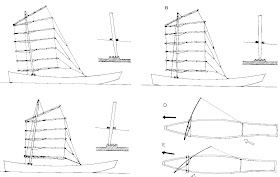As elsewhere in the booklet, the English text is rather deficient. I'll present it anyway, hoping that some reader can make better sense of it than I can:
How to mast or how to make sail differs according to the strength or direction of the wind.The angle of a mast is adjustable by changing the position of HAIUSHIMI [i.e., mast step]. [Of course, the mast step doesn't move: it's the position of the mast in the step that changes.]
When the wind is not hard , the mast is set up vertically as shown in Fig. B and when the wind is hard, the mast is inclined towards the stern as shown in Fig. C, sometimes with the sail taken in a reef by one FUZAN's [i.e., batten's] length.
Since the way to mast SABANI is not complicated it can easily meet the change of the winds. Quartering (MASUBI) is easiest for SABANI to sail, with its sail open as shown in Fig. D.
Sailing with wind abeam or quatering (sic) is called USAGIBAI or USAGIBARASHI, then a skipper sits in the middle to draw the boat deep so as not to be driven sideways by the wind, as is shown in Fig. E.
Whew! Hard to make sense of that, aside from the interesting point about the skipper moving forward to try to increase the lateral plane when the wind's abeam. Considering that there's no built-in lateral plane (leeboard, keel, outrigger float, etc.), one wonders how well sabanis go to windward.
I also question the angling of the mast depending on the strength of the wind. I suspect that the real function of the multi-position mast step is to change the fore-and-aft location of the center of effort, as on a windsurfer, to aid in steering -- i.e., tilt the mast forward when heading downwind, and tilt the mast aft when heading upwind.

Dear Bob:
ReplyDeleteThanks a lot for to put new information about this singular detail.
Maybe it is not very academic to say here that I was (happiliy) surprised seeing once more this little enigma with new drawings explanations.
As far I know the notice of raking the mast when the wind increases may be not so strange as sounds.
This is the case I know in the Galician traditional boats . And again with three holes in the mast step. Why? Well, in factthe fishermen told that it is because in this way the center of effort is more low and the boat can resist higher winds and waves . Of course they are talking under an empirical point of wiew because they did'nt know what is a "center of effort" from a scientific vision. Anyway they know very well what the effects are in sailing this way of mast and sail position. Also it is posible to combine with the reefs of the sail. In this japanese case their equivalent is to take one or more battened portion of sail.
The main difference is that in the galician rig the mast never rakes fore.In all the cases the mast can be raked at aft. And both in flat bottom as keeled boats. The flat-bottomed boats, by the way, had a very deep and wide rudder . With this help they can sail close hauling not much, sure, but they can do.
I've seen a fore mast raked in some types of junks of China that I was seeing yesterday in my tiny library of traditional boats. I wonder if this is the case also in China. Could it be possible?
At this moment I don't remenber which steering device uses the japanese boat. Have they any kind of rudder? Or maybe use a paddle as a steering oar ? If so I think it is possible use here at the fore part of the boat for to correct the drift when they sailing close the wind. Not much, yes, but in a short leg this use is reasonable...
Now I have to go . Thanks again for the post!
The sabini is indeed steered with a steering oar -- or perhaps it's actually a steering paddle: I see no reference in Shiraishi to any kind of binding, oarlock, notch, or other connection for the oar. According to Shiraishi, the helmsman also always holds the mainsheet in his hands, and never ties or cleats it off because of the boat's instability. This means the helmsman always has his hands really full -- maybe too full to even wipe the nervous sweat from his brow.
ReplyDeleteBecky - I think your sources are probably correct. The sabani is quite narrow and has no outrigger for stablilty, and would be prone to swamping and/or capsizing in serious sea conditions. The author of the book from which this post's drawings come asserts that the sabani is unstable.
ReplyDeleteIt's quite possible that on rare occasions sabani did make successful bluewater voyages -- indeed, virtually any boat can, given a lot of luck, skill, determination, and great weater conditions. But I'd be surprised if any such voyages were made intentionally and at the voyagers' complete discretion. They would likely have occurred by accident or by force of absolute necessity.